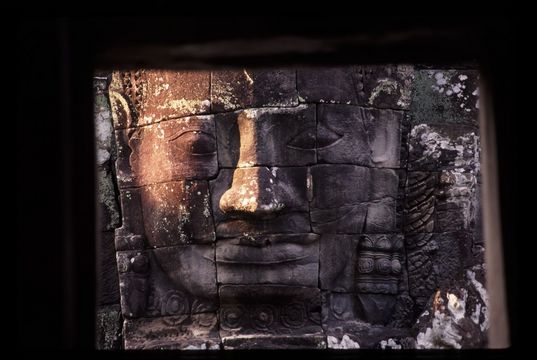 Statue of Avalokitesvara, the Bayon, ruins of Angkor. Avalokitesvara is a Buddhist deity who has postponed his own Buddhahood in order to be on the watch for the problems of people in distress, and to help all people reach enlightenment. The Khmers were in the process of becoming more Buddhist -- and combining it with Hinduism -- at the same time that they were building the temples of Angkor, so both are represented in the carvings. Avalokitesvara was always carved with four faces, one to each direction, to indicate that he was watching everywhere.
Statue of Avalokitesvara, the Bayon, ruins of Angkor. Avalokitesvara is a Buddhist deity who has postponed his own Buddhahood in order to be on the watch for the problems of people in distress, and to help all people reach enlightenment. The Khmers were in the process of becoming more Buddhist -- and combining it with Hinduism -- at the same time that they were building the temples of Angkor, so both are represented in the carvings. Avalokitesvara was always carved with four faces, one to each direction, to indicate that he was watching everywhere.
|
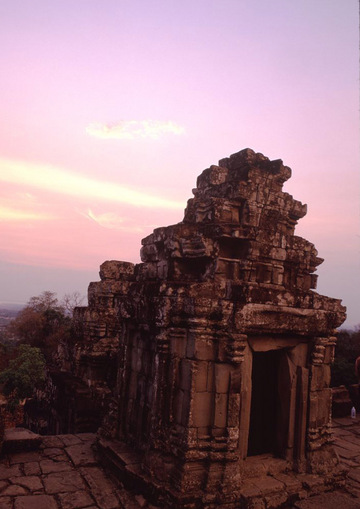 Another temple atop Temple on Phenom Bakeng.
Another temple atop Temple on Phenom Bakeng. |
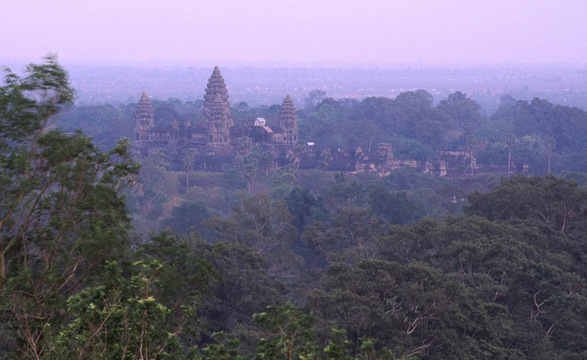 Angkor Wat, the central temple.
Angkor Wat, the central temple. |
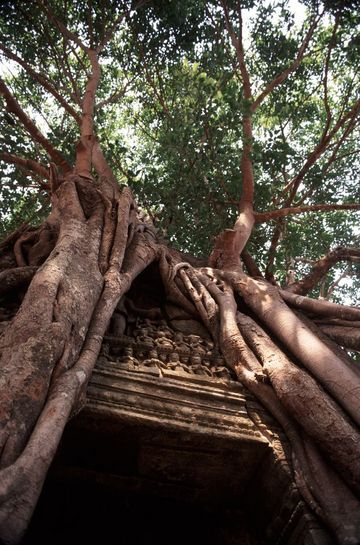 Trees engulf part of a temple, Ta Prohm. The French and Cambodians have kept the other sections of Angkor clear of vegetation, but they left the trees to grow in Ta Prohm. Although it means the slow destruction of the site, the atmosphere of decay to it is wonderful.
Trees engulf part of a temple, Ta Prohm. The French and Cambodians have kept the other sections of Angkor clear of vegetation, but they left the trees to grow in Ta Prohm. Although it means the slow destruction of the site, the atmosphere of decay to it is wonderful. |
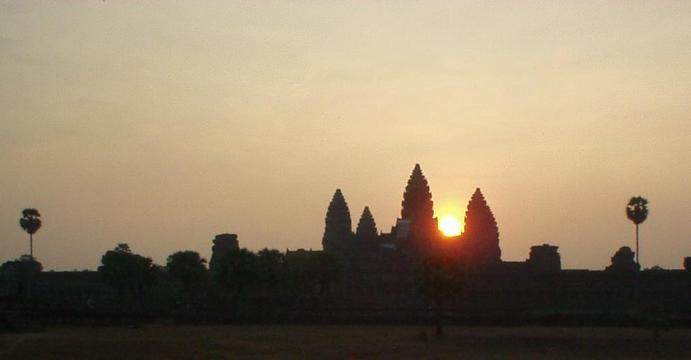 Finally something cheery about Cambodia: I feel like I've uploaded too many pictures of skulls, for what is basically a very cheerful place. This is the ruins of Angkor, built by the Khmers (Cambodians, basically) from the 9th to 12th centuries. Most of the big stuff was done in the 12th centuries: the largest volume by Jayavarman VII ("the Donald Trump of the Khmers" wrote Lonely Planet) and Suryavarvan II, who built the main site of Angkor Wat, picutred here.
Finally something cheery about Cambodia: I feel like I've uploaded too many pictures of skulls, for what is basically a very cheerful place. This is the ruins of Angkor, built by the Khmers (Cambodians, basically) from the 9th to 12th centuries. Most of the big stuff was done in the 12th centuries: the largest volume by Jayavarman VII ("the Donald Trump of the Khmers" wrote Lonely Planet) and Suryavarvan II, who built the main site of Angkor Wat, picutred here. |
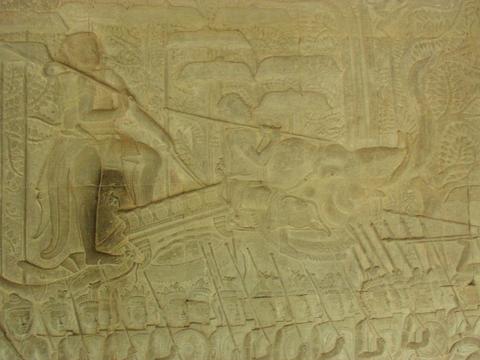 The outer wall of Angkor Wat is carved with bas-reliefs of various scenes, mostly from Hinduism. This one is the battle of Kurukshetra, from the Mahabharata; this is one of the generals riding an elephant. The scale is astonishing: there are eight bas reliefs, totalling eight hundred meters in length. That's a lotta stonecutters.
The outer wall of Angkor Wat is carved with bas-reliefs of various scenes, mostly from Hinduism. This one is the battle of Kurukshetra, from the Mahabharata; this is one of the generals riding an elephant. The scale is astonishing: there are eight bas reliefs, totalling eight hundred meters in length. That's a lotta stonecutters. |
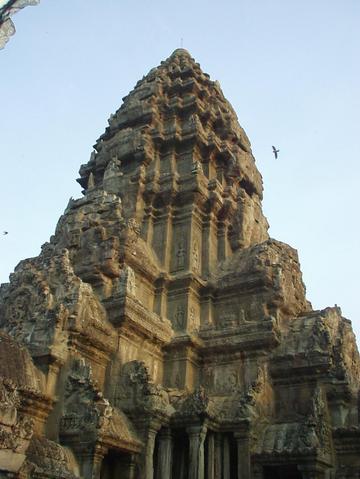 One of the towers of Angkor Wat.
One of the towers of Angkor Wat. |
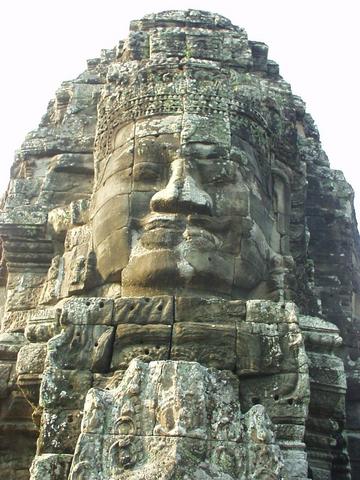 Statue of Avalokitesvara, the Bayon, ruins of Angkor. Avalokitesvara is a Buddhist deity who has postponed his own Buddhahood in order to be on the watch for the problems of people in distress, and to help all people reach enlightenment. The Khmers were in the process of becoming more Buddhist -- and combining it with Hinduism -- at the same time that they were building the temples of Angkor, so both are represented in the carvings. Avalokitesvara was always carved with four faces, one to each direction, to indicate that he was watching everywhere.
Statue of Avalokitesvara, the Bayon, ruins of Angkor. Avalokitesvara is a Buddhist deity who has postponed his own Buddhahood in order to be on the watch for the problems of people in distress, and to help all people reach enlightenment. The Khmers were in the process of becoming more Buddhist -- and combining it with Hinduism -- at the same time that they were building the temples of Angkor, so both are represented in the carvings. Avalokitesvara was always carved with four faces, one to each direction, to indicate that he was watching everywhere. |
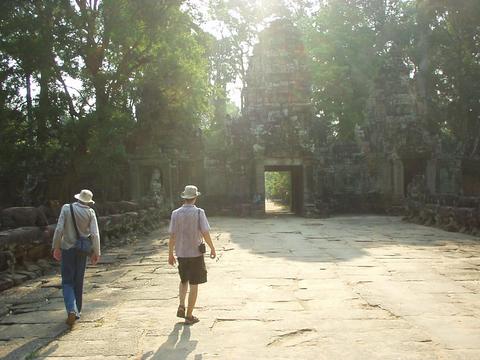 Will and Alex walking towards Preah Khan. If it appears that Will is going to collapse, it could have been that it was at least ninety degrees and high humidity.
Will and Alex walking towards Preah Khan. If it appears that Will is going to collapse, it could have been that it was at least ninety degrees and high humidity. |
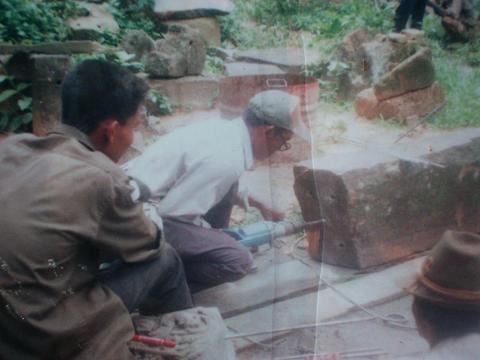 This is a photograph of a photograph of restoration work to the ruins that was on display in the Visitor's Center. Angkor Wat was "discovered" by French naturalist Henri Mouhot in the 1860s, and has been filled with Frenchmen engaged in restoration work ever since, except for a twenty-year break during the Khmer Rouge regime. They take a bit of liberty in the process, installing rebar (as here) and straigtening out leaning structures or flat-out rebuilding ones that have collapsed.
This is a photograph of a photograph of restoration work to the ruins that was on display in the Visitor's Center. Angkor Wat was "discovered" by French naturalist Henri Mouhot in the 1860s, and has been filled with Frenchmen engaged in restoration work ever since, except for a twenty-year break during the Khmer Rouge regime. They take a bit of liberty in the process, installing rebar (as here) and straigtening out leaning structures or flat-out rebuilding ones that have collapsed. |
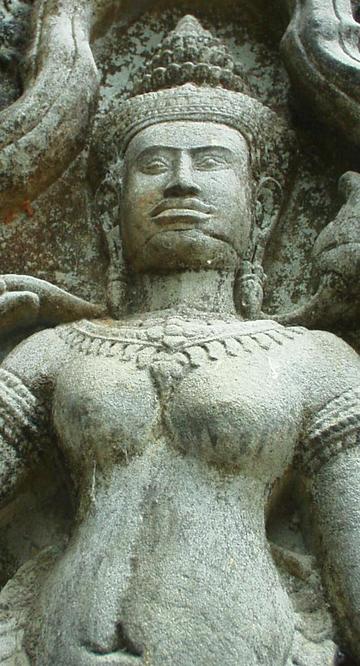 Luscious Khmer babe. I don't recall where this was, but I think it was Ta Prohm.
Luscious Khmer babe. I don't recall where this was, but I think it was Ta Prohm. |
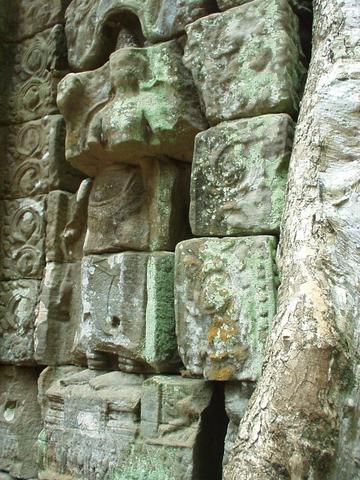 Disintegrating statue, Ta Prohm, Angkor. Ta Prohm was the most otherworldly of all of the ruins, since the French hadn't touched it: it was overgrown with jungle, where swelling, sprawling boa-constrictor roots wrapped around the stones and squeezed them to pieces.
Disintegrating statue, Ta Prohm, Angkor. Ta Prohm was the most otherworldly of all of the ruins, since the French hadn't touched it: it was overgrown with jungle, where swelling, sprawling boa-constrictor roots wrapped around the stones and squeezed them to pieces. |
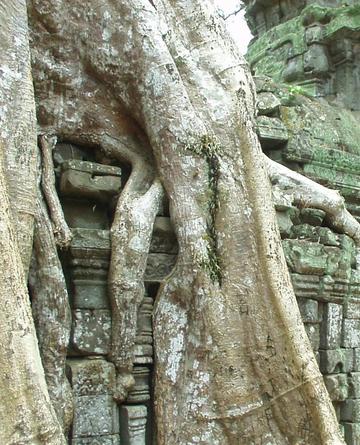 Roots squeezing rocks, Ta Prohm, Angkor.
Roots squeezing rocks, Ta Prohm, Angkor. |
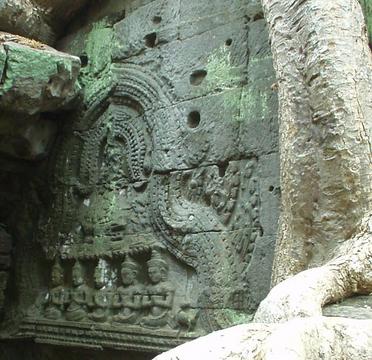 Five little buddhists and a tree, at Ta Prohm. My moto driver that was taking me around to the various sites pointed out that Tomb Raider was filmed here ("This is hotel where Angelina Jolie stayed, you see?"). It was the first major production film made in Cambodia since Lord Jim in 1964.
Five little buddhists and a tree, at Ta Prohm. My moto driver that was taking me around to the various sites pointed out that Tomb Raider was filmed here ("This is hotel where Angelina Jolie stayed, you see?"). It was the first major production film made in Cambodia since Lord Jim in 1964. |
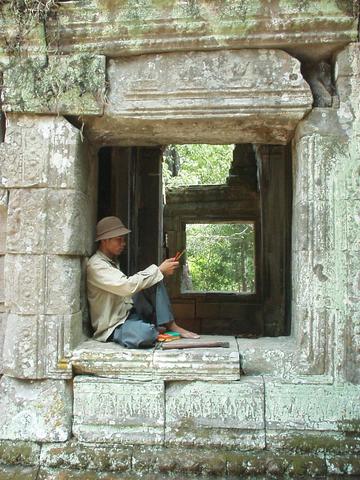 Cambodian man lounging in a window at Ta Prohm, Angkor. Cleaning and restoration were very much in evidence at the Angkor ruins -- which they ought to be, at twenty clams a ticket.
Cambodian man lounging in a window at Ta Prohm, Angkor. Cleaning and restoration were very much in evidence at the Angkor ruins -- which they ought to be, at twenty clams a ticket. |
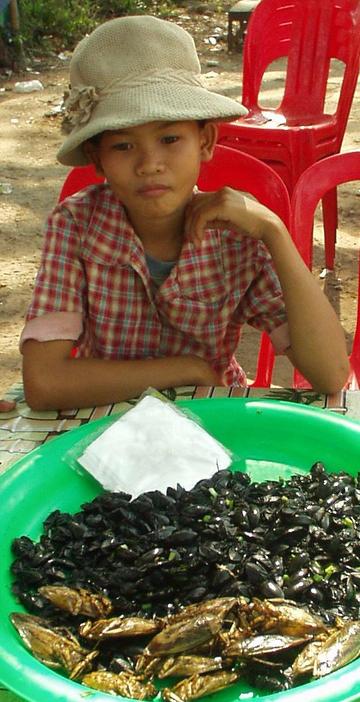 Put that can of Raid down, you'll ruin my snack! This is not a novelty; the usual lineup at a Cambodian food stand goes: corn on the cob, pineapple and other fruits, cockroaches, tarantulas, baguettes... people actually eat them, leaving abdomen-less cockroach carcasses lying about.
Put that can of Raid down, you'll ruin my snack! This is not a novelty; the usual lineup at a Cambodian food stand goes: corn on the cob, pineapple and other fruits, cockroaches, tarantulas, baguettes... people actually eat them, leaving abdomen-less cockroach carcasses lying about. |
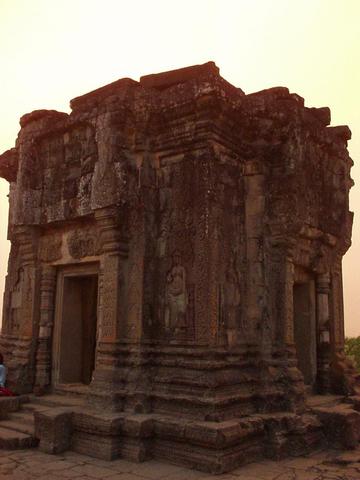 Temple on Phenom Bakeng, Angkor at sunset. "Phenom" is the Khmer word for "hill", hence it's appearance both in "Phenom Penh" as well as here. Phenom Bakeng is THE place to see sunset at the Angkor ruins; it gets to be a bit of a circus.
Temple on Phenom Bakeng, Angkor at sunset. "Phenom" is the Khmer word for "hill", hence it's appearance both in "Phenom Penh" as well as here. Phenom Bakeng is THE place to see sunset at the Angkor ruins; it gets to be a bit of a circus. |
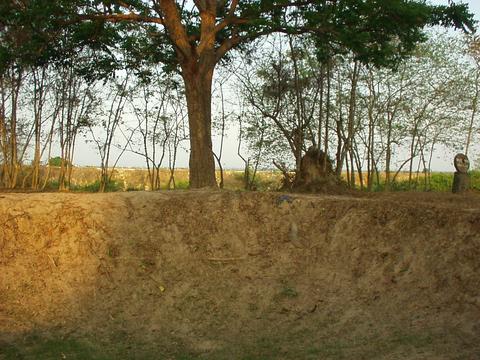 This is probably the dullest photograph on xenotropic, but it's just what the killing fields looked like: a few trees, and large pits. It was a powerful scene, however, in that around a thousand people had knelt at the edge of each pit and either shot in the back of the head, or more often hit at the base of the skull to conserve bullets, by Pol Pot's goons. Most were killed in the years 1975-1979.
This is probably the dullest photograph on xenotropic, but it's just what the killing fields looked like: a few trees, and large pits. It was a powerful scene, however, in that around a thousand people had knelt at the edge of each pit and either shot in the back of the head, or more often hit at the base of the skull to conserve bullets, by Pol Pot's goons. Most were killed in the years 1975-1979. |
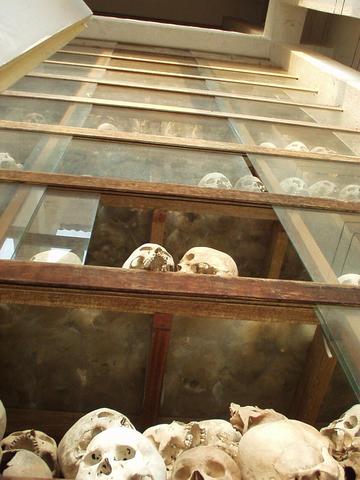 Skulls inside the wat at the killing fields.
Skulls inside the wat at the killing fields. |
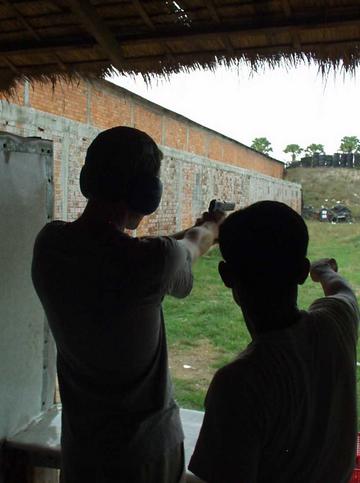 Firing a Colt .45, Phenom Penh. Cambodia has a lot of weaponry left over from the last two decades; I guess it is somewhat heartening that it's primary use is now as a tourist attraction.
Firing a Colt .45, Phenom Penh. Cambodia has a lot of weaponry left over from the last two decades; I guess it is somewhat heartening that it's primary use is now as a tourist attraction. |
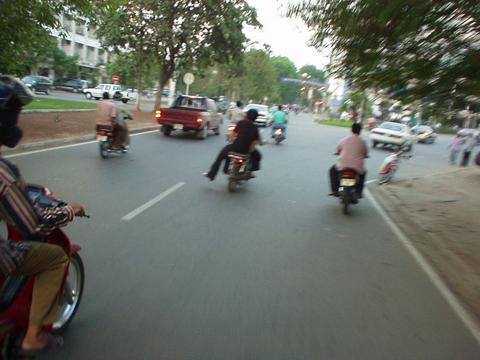 The standard way of getting around in Cambodia is by moto-taxi, which is mildly harrowing; but the roads in Phenom Penh are quite well maintained, and the city is a pleasant size: bigger than rural Viantiane, and smaller than the hype and glare of Bangkok.
The standard way of getting around in Cambodia is by moto-taxi, which is mildly harrowing; but the roads in Phenom Penh are quite well maintained, and the city is a pleasant size: bigger than rural Viantiane, and smaller than the hype and glare of Bangkok. |
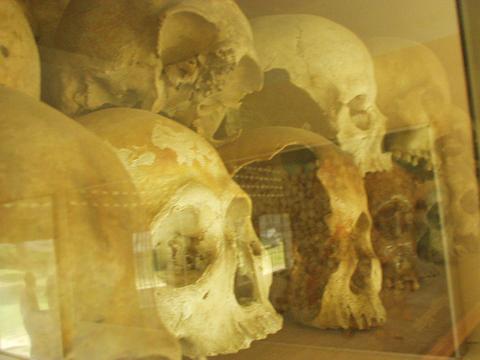 Skulls of those killed by the Khmer Rouge, S-21 concentration camp, Phenom Penh. The Khmer Rouge stifled the Cambodian people between 1975 and 1996, in a similar way to Mao's Cultural Revolution in China, clearing out cities and prosecuting political opposition and pretty much anyone with an education. In the last seven years there has been a great return to civility, and the country seems to be well underway in the process of rebuilding.
Skulls of those killed by the Khmer Rouge, S-21 concentration camp, Phenom Penh. The Khmer Rouge stifled the Cambodian people between 1975 and 1996, in a similar way to Mao's Cultural Revolution in China, clearing out cities and prosecuting political opposition and pretty much anyone with an education. In the last seven years there has been a great return to civility, and the country seems to be well underway in the process of rebuilding. |
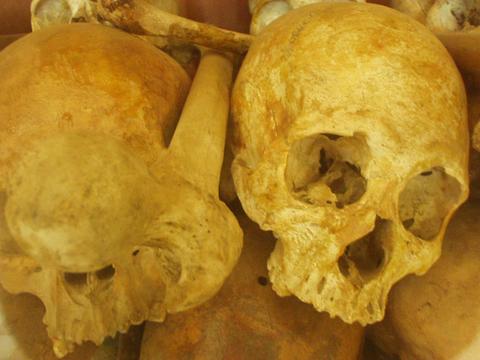 In the years 1975-1979 the S-21 prison in Phenom Penh saw the execution of around 4,000 political prisoners a year, many of them taken to the "killing fields" (hence the movie of the same name, which I have yet to see) of Cheung Ek. A total of two million Cambodian deaths are attributed to the Khmer Rouge, which is all the more staggering when you consider that the violence occurred between people of the same religion, language, and culture.
In the years 1975-1979 the S-21 prison in Phenom Penh saw the execution of around 4,000 political prisoners a year, many of them taken to the "killing fields" (hence the movie of the same name, which I have yet to see) of Cheung Ek. A total of two million Cambodian deaths are attributed to the Khmer Rouge, which is all the more staggering when you consider that the violence occurred between people of the same religion, language, and culture. |
 Statue of Avalokitesvara, the Bayon, ruins of Angkor. Avalokitesvara is a Buddhist deity who has postponed his own Buddhahood in order to be on the watch for the problems of people in distress, and to help all people reach enlightenment. The Khmers were in the process of becoming more Buddhist -- and combining it with Hinduism -- at the same time that they were building the temples of Angkor, so both are represented in the carvings. Avalokitesvara was always carved with four faces, one to each direction, to indicate that he was watching everywhere.
Statue of Avalokitesvara, the Bayon, ruins of Angkor. Avalokitesvara is a Buddhist deity who has postponed his own Buddhahood in order to be on the watch for the problems of people in distress, and to help all people reach enlightenment. The Khmers were in the process of becoming more Buddhist -- and combining it with Hinduism -- at the same time that they were building the temples of Angkor, so both are represented in the carvings. Avalokitesvara was always carved with four faces, one to each direction, to indicate that he was watching everywhere.
 Another temple atop Temple on Phenom Bakeng.
Another temple atop Temple on Phenom Bakeng. Angkor Wat, the central temple.
Angkor Wat, the central temple. Trees engulf part of a temple, Ta Prohm. The French and Cambodians have kept the other sections of Angkor clear of vegetation, but they left the trees to grow in Ta Prohm. Although it means the slow destruction of the site, the atmosphere of decay to it is wonderful.
Trees engulf part of a temple, Ta Prohm. The French and Cambodians have kept the other sections of Angkor clear of vegetation, but they left the trees to grow in Ta Prohm. Although it means the slow destruction of the site, the atmosphere of decay to it is wonderful. Finally something cheery about Cambodia: I feel like I've uploaded too many pictures of skulls, for what is basically a very cheerful place. This is the ruins of Angkor, built by the Khmers (Cambodians, basically) from the 9th to 12th centuries. Most of the big stuff was done in the 12th centuries: the largest volume by Jayavarman VII ("the Donald Trump of the Khmers" wrote Lonely Planet) and Suryavarvan II, who built the main site of Angkor Wat, picutred here.
Finally something cheery about Cambodia: I feel like I've uploaded too many pictures of skulls, for what is basically a very cheerful place. This is the ruins of Angkor, built by the Khmers (Cambodians, basically) from the 9th to 12th centuries. Most of the big stuff was done in the 12th centuries: the largest volume by Jayavarman VII ("the Donald Trump of the Khmers" wrote Lonely Planet) and Suryavarvan II, who built the main site of Angkor Wat, picutred here. The outer wall of Angkor Wat is carved with bas-reliefs of various scenes, mostly from Hinduism. This one is the battle of Kurukshetra, from the Mahabharata; this is one of the generals riding an elephant. The scale is astonishing: there are eight bas reliefs, totalling eight hundred meters in length. That's a lotta stonecutters.
The outer wall of Angkor Wat is carved with bas-reliefs of various scenes, mostly from Hinduism. This one is the battle of Kurukshetra, from the Mahabharata; this is one of the generals riding an elephant. The scale is astonishing: there are eight bas reliefs, totalling eight hundred meters in length. That's a lotta stonecutters. One of the towers of Angkor Wat.
One of the towers of Angkor Wat. Statue of Avalokitesvara, the Bayon, ruins of Angkor. Avalokitesvara is a Buddhist deity who has postponed his own Buddhahood in order to be on the watch for the problems of people in distress, and to help all people reach enlightenment. The Khmers were in the process of becoming more Buddhist -- and combining it with Hinduism -- at the same time that they were building the temples of Angkor, so both are represented in the carvings. Avalokitesvara was always carved with four faces, one to each direction, to indicate that he was watching everywhere.
Statue of Avalokitesvara, the Bayon, ruins of Angkor. Avalokitesvara is a Buddhist deity who has postponed his own Buddhahood in order to be on the watch for the problems of people in distress, and to help all people reach enlightenment. The Khmers were in the process of becoming more Buddhist -- and combining it with Hinduism -- at the same time that they were building the temples of Angkor, so both are represented in the carvings. Avalokitesvara was always carved with four faces, one to each direction, to indicate that he was watching everywhere. Will and Alex walking towards Preah Khan. If it appears that Will is going to collapse, it could have been that it was at least ninety degrees and high humidity.
Will and Alex walking towards Preah Khan. If it appears that Will is going to collapse, it could have been that it was at least ninety degrees and high humidity. This is a photograph of a photograph of restoration work to the ruins that was on display in the Visitor's Center. Angkor Wat was "discovered" by French naturalist Henri Mouhot in the 1860s, and has been filled with Frenchmen engaged in restoration work ever since, except for a twenty-year break during the Khmer Rouge regime. They take a bit of liberty in the process, installing rebar (as here) and straigtening out leaning structures or flat-out rebuilding ones that have collapsed.
This is a photograph of a photograph of restoration work to the ruins that was on display in the Visitor's Center. Angkor Wat was "discovered" by French naturalist Henri Mouhot in the 1860s, and has been filled with Frenchmen engaged in restoration work ever since, except for a twenty-year break during the Khmer Rouge regime. They take a bit of liberty in the process, installing rebar (as here) and straigtening out leaning structures or flat-out rebuilding ones that have collapsed. Luscious Khmer babe. I don't recall where this was, but I think it was Ta Prohm.
Luscious Khmer babe. I don't recall where this was, but I think it was Ta Prohm. Disintegrating statue, Ta Prohm, Angkor. Ta Prohm was the most otherworldly of all of the ruins, since the French hadn't touched it: it was overgrown with jungle, where swelling, sprawling boa-constrictor roots wrapped around the stones and squeezed them to pieces.
Disintegrating statue, Ta Prohm, Angkor. Ta Prohm was the most otherworldly of all of the ruins, since the French hadn't touched it: it was overgrown with jungle, where swelling, sprawling boa-constrictor roots wrapped around the stones and squeezed them to pieces. Roots squeezing rocks, Ta Prohm, Angkor.
Roots squeezing rocks, Ta Prohm, Angkor. Five little buddhists and a tree, at Ta Prohm. My moto driver that was taking me around to the various sites pointed out that Tomb Raider was filmed here ("This is hotel where Angelina Jolie stayed, you see?"). It was the first major production film made in Cambodia since Lord Jim in 1964.
Five little buddhists and a tree, at Ta Prohm. My moto driver that was taking me around to the various sites pointed out that Tomb Raider was filmed here ("This is hotel where Angelina Jolie stayed, you see?"). It was the first major production film made in Cambodia since Lord Jim in 1964. Cambodian man lounging in a window at Ta Prohm, Angkor. Cleaning and restoration were very much in evidence at the Angkor ruins -- which they ought to be, at twenty clams a ticket.
Cambodian man lounging in a window at Ta Prohm, Angkor. Cleaning and restoration were very much in evidence at the Angkor ruins -- which they ought to be, at twenty clams a ticket. Put that can of Raid down, you'll ruin my snack! This is not a novelty; the usual lineup at a Cambodian food stand goes: corn on the cob, pineapple and other fruits, cockroaches, tarantulas, baguettes... people actually eat them, leaving abdomen-less cockroach carcasses lying about.
Put that can of Raid down, you'll ruin my snack! This is not a novelty; the usual lineup at a Cambodian food stand goes: corn on the cob, pineapple and other fruits, cockroaches, tarantulas, baguettes... people actually eat them, leaving abdomen-less cockroach carcasses lying about. Temple on Phenom Bakeng, Angkor at sunset. "Phenom" is the Khmer word for "hill", hence it's appearance both in "Phenom Penh" as well as here. Phenom Bakeng is THE place to see sunset at the Angkor ruins; it gets to be a bit of a circus.
Temple on Phenom Bakeng, Angkor at sunset. "Phenom" is the Khmer word for "hill", hence it's appearance both in "Phenom Penh" as well as here. Phenom Bakeng is THE place to see sunset at the Angkor ruins; it gets to be a bit of a circus. This is probably the dullest photograph on xenotropic, but it's just what the killing fields looked like: a few trees, and large pits. It was a powerful scene, however, in that around a thousand people had knelt at the edge of each pit and either shot in the back of the head, or more often hit at the base of the skull to conserve bullets, by Pol Pot's goons. Most were killed in the years 1975-1979.
This is probably the dullest photograph on xenotropic, but it's just what the killing fields looked like: a few trees, and large pits. It was a powerful scene, however, in that around a thousand people had knelt at the edge of each pit and either shot in the back of the head, or more often hit at the base of the skull to conserve bullets, by Pol Pot's goons. Most were killed in the years 1975-1979. Skulls inside the wat at the killing fields.
Skulls inside the wat at the killing fields. Firing a Colt .45, Phenom Penh. Cambodia has a lot of weaponry left over from the last two decades; I guess it is somewhat heartening that it's primary use is now as a tourist attraction.
Firing a Colt .45, Phenom Penh. Cambodia has a lot of weaponry left over from the last two decades; I guess it is somewhat heartening that it's primary use is now as a tourist attraction. The standard way of getting around in Cambodia is by moto-taxi, which is mildly harrowing; but the roads in Phenom Penh are quite well maintained, and the city is a pleasant size: bigger than rural Viantiane, and smaller than the hype and glare of Bangkok.
The standard way of getting around in Cambodia is by moto-taxi, which is mildly harrowing; but the roads in Phenom Penh are quite well maintained, and the city is a pleasant size: bigger than rural Viantiane, and smaller than the hype and glare of Bangkok. Skulls of those killed by the Khmer Rouge, S-21 concentration camp, Phenom Penh. The Khmer Rouge stifled the Cambodian people between 1975 and 1996, in a similar way to Mao's Cultural Revolution in China, clearing out cities and prosecuting political opposition and pretty much anyone with an education. In the last seven years there has been a great return to civility, and the country seems to be well underway in the process of rebuilding.
Skulls of those killed by the Khmer Rouge, S-21 concentration camp, Phenom Penh. The Khmer Rouge stifled the Cambodian people between 1975 and 1996, in a similar way to Mao's Cultural Revolution in China, clearing out cities and prosecuting political opposition and pretty much anyone with an education. In the last seven years there has been a great return to civility, and the country seems to be well underway in the process of rebuilding. In the years 1975-1979 the S-21 prison in Phenom Penh saw the execution of around 4,000 political prisoners a year, many of them taken to the "killing fields" (hence the movie of the same name, which I have yet to see) of Cheung Ek. A total of two million Cambodian deaths are attributed to the Khmer Rouge, which is all the more staggering when you consider that the violence occurred between people of the same religion, language, and culture.
In the years 1975-1979 the S-21 prison in Phenom Penh saw the execution of around 4,000 political prisoners a year, many of them taken to the "killing fields" (hence the movie of the same name, which I have yet to see) of Cheung Ek. A total of two million Cambodian deaths are attributed to the Khmer Rouge, which is all the more staggering when you consider that the violence occurred between people of the same religion, language, and culture.